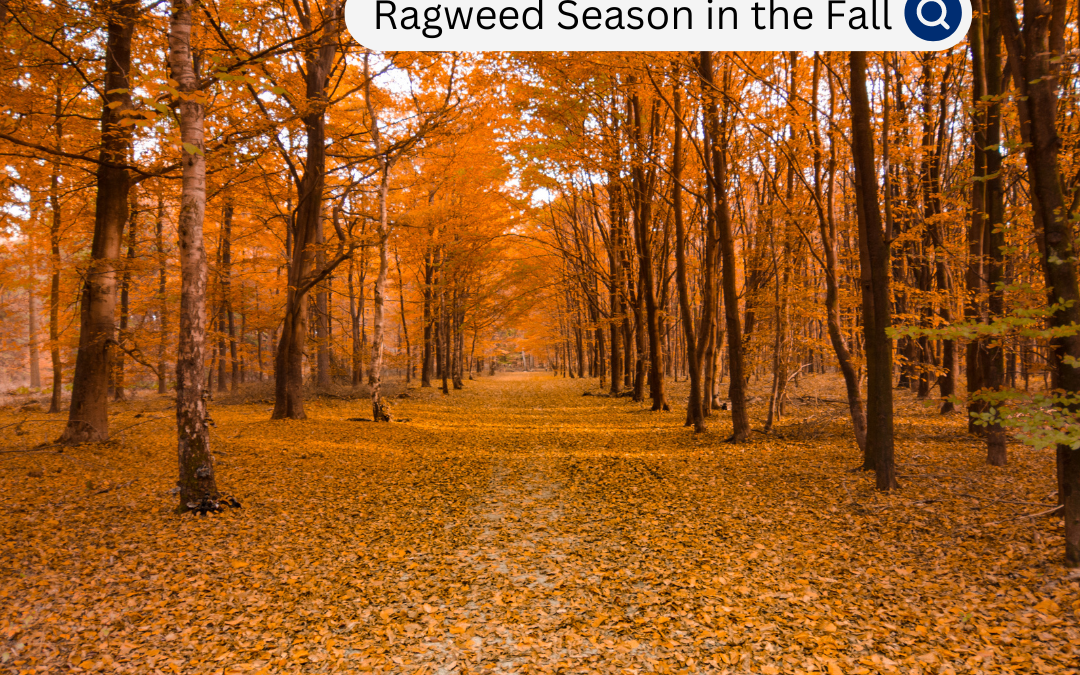As fall settles in across the Midwest, the changing landscape of vibrant leaves and crisp air brings with it a surge in ragweed allergies. For many people, autumn isn’t just about enjoying pumpkin spice lattes and cozy sweaters; it’s also the peak of ragweed pollen season. Understanding how ragweed affects those with allergies and how to manage symptoms is essential for making the most of this beautiful season. At Premier Allergy, Asthma, & Sinus Care, we’re not only Chicago natives but we’re experts in allergies.
Understanding Ragweed and Its Impact
Ragweed is a common allergen that thrives during late summer and fall. Its pollen is lightweight and easily dispersed by the wind, which means it can travel long distances and infiltrate indoor spaces. The Midwest, with its expansive agricultural fields and diverse vegetation, is particularly susceptible to high ragweed pollen counts. This pollen season typically peaks from late August to November, making it a challenging time for allergy sufferers.
Ragweed pollen is known for causing seasonal allergic rhinitis, also known as hay fever. Common symptoms include:
-
Sneezing
-
Runny or stuffy nose
-
Itchy or watery eyes
-
Post-nasal drip
-
Coughing
-
Fatigue
In more severe cases, ragweed allergies can exacerbate asthma symptoms or lead to sinus infections.
Why Ragweed Pollen is So Pervasive
Ragweed plants are highly prolific and produce enormous amounts of pollen. A single ragweed plant can release up to a billion grains of pollen in a season. This pollen is small and lightweight, allowing it to become airborne easily. Once in the air, it can travel for miles, affecting people far from the source of the pollen.
The Midwest’s climate and geography also contribute to high ragweed pollen counts. Warm temperatures and periodic rain create ideal conditions for ragweed growth. Moreover, the region’s agricultural practices often involve tilling and soil disturbance, which can spread ragweed seeds and further increase pollen levels.
Managing Ragweed Allergies: Tips and Strategies
If you suffer from ragweed allergies, it’s crucial to adopt strategies that help minimize your exposure to pollen and manage symptoms effectively. Here are some practical tips to consider:
1. Monitor Pollen Counts: Keep an eye on local pollen forecasts. Many weather apps and websites provide daily updates on pollen levels. On days when pollen counts are high, try to stay indoors as much as possible, especially during peak pollen times, which are typically in the morning and early evening.
2. Limit Outdoor Activities: On high pollen days, reduce outdoor activities or plan them for times when pollen counts are lower. If you need to be outside, avoid strenuous exercise, which can exacerbate allergy symptoms. Opt for low-intensity activities and try to stay in areas with less vegetation.
3. Keep Windows Closed: To prevent pollen from entering your home, keep windows closed during the day, particularly on high pollen days. Use air conditioning with a HEPA filter to help trap pollen and maintain indoor air quality.
4. Change and Wash Clothes: After spending time outdoors, change your clothes and wash your hands and face to remove pollen that may have accumulated. This simple step can help reduce the amount of pollen that enters your home.
5. Use a HEPA Filter: Invest in a high-efficiency particulate air (HEPA) filter for your home’s air conditioning and heating systems. HEPA filters are designed to capture fine particles, including pollen, which can help improve indoor air quality.
6. Consider Allergy Medications: Over-the-counter antihistamines, decongestants, and nasal corticosteroids can provide relief from allergy symptoms. Consult with your healthcare provider to determine the best medication for your specific needs. In some cases, allergy shots (immunotherapy) may be recommended for long-term relief.
7. Keep Your Home Clean: Regular cleaning can help reduce indoor allergens. Vacuum carpets and upholstery frequently using a vacuum with a HEPA filter. Wash bedding, curtains, and other fabrics regularly to remove accumulated pollen.
8. Stay Hydrated: Drinking plenty of water can help keep your mucus membranes hydrated and may alleviate some allergy symptoms. Herbal teas with anti-inflammatory properties, such as chamomile or peppermint, can also be soothing.
When to Seek Medical Advice
While these strategies can help manage ragweed allergies, it’s important to consult with an allergy provider if you experience severe or persistent symptoms. An allergist can perform diagnostic tests to identify specific allergens and develop a personalized treatment plan. If you have asthma or other underlying health conditions, managing your allergies effectively is crucial for overall well-being.
In some cases, symptoms may indicate complications such as sinus infections or worsening asthma. If you experience any of the following, seek medical advice promptly:
-
Severe or persistent symptoms despite medication
-
Difficulty breathing or wheezing
-
Frequent sinus infections
-
Persistent cough that interferes with daily activities
Embracing Fall While Managing Allergies
Despite the challenges posed by ragweed allergies, fall in the Midwest remains a season of stunning natural beauty and enjoyable activities. By taking proactive steps to manage your allergies, you can fully embrace the season’s offerings. Enjoy scenic drives through colorful foliage, cozy up with a warm beverage, and partake in fall festivals—all while keeping your allergy symptoms in check.
With proper management and awareness, you can make the most of fall in the Midwest and savor all the wonderful experiences it has to offer. So grab your favorite sweater, enjoy the crisp air, and relish the beauty of the season—just don’t forget your allergy management strategies!
As we navigate the fall season in the Midwest, understanding and managing ragweed allergies is crucial for maintaining a good quality of life. By implementing effective strategies and staying informed about pollen counts, you can minimize the impact of ragweed on your daily activities and fully enjoy the beauty of autumn.
Remember, if you have concerns about your allergy symptoms or need personalized advice, consulting with an allergy provider can provide valuable insights and tailored solutions. At Premier Allergy, Asthma, & Sinus Care, we are here for you and want to help you make the most of the Fall season.
Here’s to a season of vibrant colors, crisp air, and manageable allergies!





